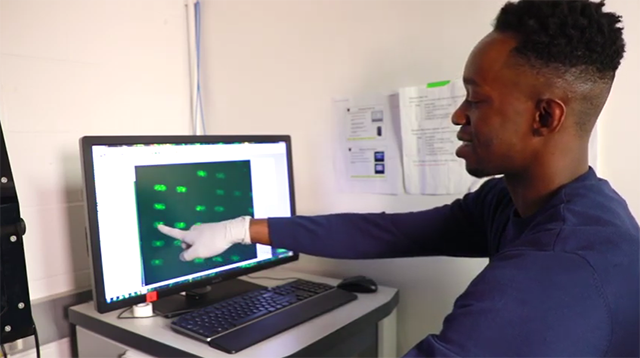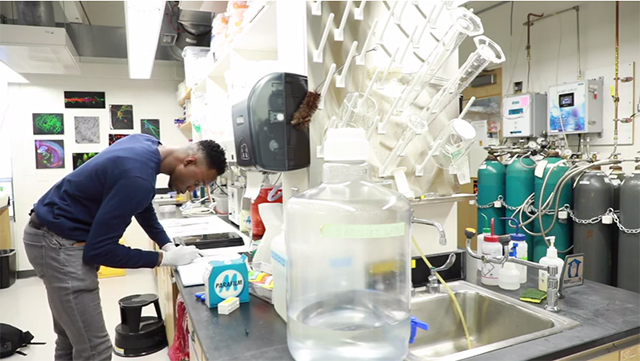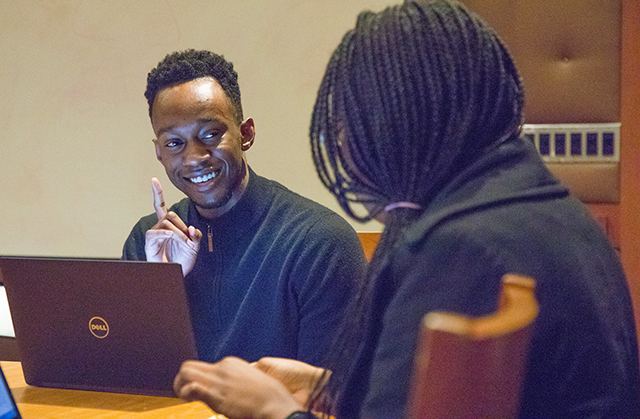How did you become interested in science and engineering?
I’ve always had an interest in science, math, and problem solving. Being able to use the skills I’ve developed in a tangible way was very appealing to me. When I got to Harvard, I was set on bioengineering, in part because of my interest in medicine, but also because I feel there are a lot of opportunities in biomedical engineering for creating products and platforms that could have a significant impact on people’s lives by intervening in all sorts of diseases.
How did you get involved in research?
When I came to campus, I was pretty set on finding a lab because I wanted experience working in a research environment. The lab of Kit Parker, [Tarr Family Professor of Bioengineering and Applied Physics,] appealed to me because of its focus on cardiology and cardiovascular tissue engineering. I was also really interested in modeling the human body. We do a lot of that by developing in vitro (outside of the body) models to recapitulate the structure and function of certain organs and tissues, which then can be used for drug screening or studying disease mechanisms. I started working here in January of my freshman year, and I’ve been here continuously ever since.
What are some of the projects you’ve worked on in the Parker lab?
I’ve mainly been split into two different areas: cardiac tissue engineering and vascular endothelial modeling. For cardiac tissue engineering, I worked on a project to develop a high-throughput screening system for cardiac-acting drugs. We developed a platform that incorporated a series of miniature cardiac tissues, then used those as a means to test drugs that act on the myocardium (muscular tissue of the heart). This helps us understand how those drugs affect the myocardium, and that understanding can then be used to predict how the drugs would interact with the heart in the human body.
On the vascular endothelial modeling side, we’re using a technique called microcontact printing to pattern proteins onto surfaces. By seeding cells onto those surfaces, we can create specific cellular geometries and configurations. In this case, we’re patterning endothelial cells into pairs as minimalistic models of the vascular endothelium (cells that line the inside surface of blood vessels). We’ve used this as a tool for screening the impact of engineered nanomaterials found in all sorts of consumer products on the vascular endothelium, ultimately to understand the negative effects these materials may have on its function.

In the Parker lab, Eweje has worked on projects related to cardiac tissue engineering and vascular endothelial modeling. (Photo by Eliza Grinnell/SEAS Communications)
What are you working on for your senior thesis project?
I’m developing a model of cardiac fibrosis, a pathological process that occurs after a heart attack. A scar develops in place of the dead myocardial tissue, which is initially reparative but eventually leads to heart failure due to mismatches between the scar and surrounding live tissue. I’m seeking to recapitulate that process in a dish in the hopes of creating a tool that could be implemented as a drug-screening platform to aid in the development of therapies for the disease.
What do you enjoy about research?
For me, it all goes back to my passion for problem solving. As an engineer, you acquire skills that ultimately aid you in the development of devices and platforms that can be used to intervene in some problem. Working in a lab and conducting research is a good way of getting to the leading edge of whatever problem you’re attempting to solve. Being involved in that process and being able to create something tangible is very exciting to me.
Tell us about the research you did in South Korea.
Our lab has a collaboration with a South Korean lab that’s largely focused on biomaterials development. I spent a month in that lab developing a prototype for a tool to measure cardiac chamber volumes. Even more than the value I got out of the lab experience, being immersed in a new culture was really valuable for me in understanding how a lab operates in a different country and context.

Eweje's interest in modeling the human body inspired him to join the Parker lab as a freshman. (Photo by Eliza Grinnell/SEAS Communications)
How did you get involved with the Harvard Society of Black Scientists and Engineers?
The Harvard Society of Black Scientists and Engineers was the first organization I turned to, pretty much from the moment I arrived on campus. I became a freshman representative after a few weeks, and took a role in the leadership my sophomore year, eventually becoming president during my junior year. For me, it’s been great to be part of a community that I can turn to both for guidance and advice on academics and my career. My confidence in pursuing a research career has been significantly influenced by the people I’ve met in that organization.
What have been some of the biggest successes of the organization?
We’ve been able to get a lot of students to attend national conferences. It’s an immensely valuable opportunity, not only from a networking point of view, but particularly for students who don’t often get a chance to find people who look like them who are working in these fields. We’ve also been able to foster a community of students from all years and all science and engineering concentrations, and help them develop potentially useful connections.
What’s been rewarding about your involvement with the National Society of Black Scientists and Engineers?
Creating that community has been really valuable and rewarding for me. Being a part of this community of intelligent, successful black scientists and engineers, that’s something that I can’t speak enough about. Outside of that, I think having the opportunity to tangibly aid those people I’m connected to and contributing to their success or career goals has been really rewarding as well.

At a Harvard Society of Black Scientists and Engineers p-set night, Eweje and his peers collaborate to solve problems. (Photo by Eliza Grinnell/SEAS Communications)
Tell us about your involvement with the Kuumba Singers.
I’ve been a part of the Kuumba Singers for my entire time at Harvard. We sing music from throughout the African diaspora. That could be music from the gospel tradition, but also music that originates from the continent of Africa. We sing some R&B songs, too. Kuumba places a huge emphasis on community, which is another thing that really appealed to me. It’s not just a musical space, it’s a group of people who enjoy spending time together. Kuumba is where I’ve developed my closest friendships. And beyond that, I think I’ve also developed as a person, thinking about issues of racial inequality and how that history is expressed in the music we sing.
Has music always been a passion of yours?
I’ve been making music pretty much my entire life. I started playing the piano when I was 7 years old. In high school, I started playing jazz music on the saxophone, too. I don’t often perform, but for me, music has always been therapeutic. I enjoy being able to calmly make music and recreate the sounds that I enjoy on my own. I really appreciate having the ability to hear a song and look up some chords and just play it out, being able to listen to it and make it my own.
What are your plans for after graduation?
After graduation, I’ll be enrolling in an M.D./Ph.D. program. My hope is that pursuing these two degrees will put me in a position to eventually pursue a research career at the intersection of medicine and engineering. I’d hope to gain a professorship or an academic position in an engineering department, while continuing to practice so I can bring my clinical expertise into my research efforts within engineering. I think that the intersection of medicine and engineering is where a lot of the most pressing medical issues will be solved.
Name: Sayo Eweje
Concentration: Biomedical engineering
Graduation year: 2019
Hometown: Jacksonville, N.C.
Hobbies: Playing basketball, solving logic puzzles like Rubik’s cubes (his record is 20 seconds to solve a 3x3 Rubik’s cube)
Fun fact: He has an identical twin brother.
Press Contact
Adam Zewe | 617-496-5878 | azewe@seas.harvard.edu